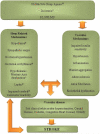Sleep disorders and stroke
- PMID: 22336145
- PMCID: PMC3387919
- DOI: 10.1111/j.1747-4949.2011.00760.x
Sleep disorders and stroke
Abstract
The purpose of this review is to highlight existing literature on the epidemiology, pathophysiology, and treatments of stroke sleep disorders. Stroke sleep disorders are associated with many intermediary vascular risk factors leading to stroke, but they may also influence these risk factors through direct or indirect mechanisms. Sleep disturbances may be further exacerbated by stroke or caused by stroke. Unrecognized and untreated sleep disorders may influence rehabilitation efforts and poor functional outcomes following stroke and increase risk for stroke recurrence. Increasing awareness and improving screening for sleep disorders is paramount in the primary and secondary prevention of stroke and in improving stroke outcomes. Many vital questions about the relationship of sleep disorders and stroke are still unanswered and await future well-designed studies.
© 2012 The Authors. International Journal of Stroke © 2012 World Stroke Organization.
Figures


References
-
- Hermann DM, Bassetti CL. Sleep-related breathing and sleep-wake disturbances in ischemic stroke. Neurology. 2009;73:1313–22. - PubMed
-
- Somers VK, White DP, Amin R, et al. Sleep apnea and cardiovascular disease: an American Heart Association/American College Of Cardiology Foundation Scientific Statement from the American Heart Association Council for High Blood Pressure Research Professional Education Committee, Council on Clinical Cardiology, Stroke Council, and Council On Cardiovascular Nursing. In collaboration with the National Heart, Lung, and Blood Institute National Center on Sleep Disorders Research (National Institutes of Health) Circulation. 2008;118:1080–111. - PubMed
-
- Culebras A. Sleep and stroke. Semin Neurol. 2009;29:438–45. - PubMed
-
- American Academy of Sleep Medicine . The International Classification of Sleep Disorders: Diagnostic and Coding Manual. 2nd edn American Academy of Sleep Medicine; Westchester, IL: 2005.
-
- Guilleminault C, Ramar K. Neurologic aspects of sleep apnea: is obstructive sleep apnea a neurologic disorder? Semin Neurol. 2009;29:368–71. - PubMed
Publication types
MeSH terms
Grants and funding
LinkOut - more resources
Full Text Sources
Medical

